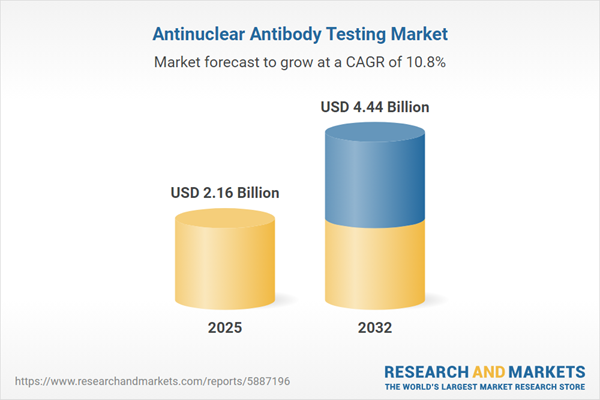Speak directly to the analyst to clarify any post sales queries you may have.
The antinuclear antibody testing market is experiencing rapid change, driven by technological advancements and evolving regulatory demands. Senior decision-makers require clear, actionable insights to guide strategy and investment in this vital B2B healthcare segment.
Market Snapshot: Antinuclear Antibody Testing Market Growth and Trends
The antinuclear antibody testing market grew from USD 1.95 billion in 2024 to USD 2.16 billion in 2025. It is expected to continue expanding at a CAGR of 10.81%, reaching USD 4.44 billion by 2032. This sizable growth reflects sustained demand for advanced diagnostic solutions in systemic autoimmune disorders, fueled by scientific innovation, expanded clinical use, and increasing worldwide awareness of autoimmune disease management.
Scope & Segmentation of the Antinuclear Antibody Testing Market
This report provides strategic coverage of the antinuclear antibody testing market, detailing the full landscape of products, technology, and regional nuances. Segmentation for informed decision-making:
- Product Types: Instruments (CLIA analyzers, ELISA readers, IFA scanners, multiplex analyzers), Kits (CLIA, ELISA, IFA, multiplex), Reagents (antigens, buffers, conjugates), Software (data analysis, laboratory information management).
- Technologies: Chemiluminescence immunoassay, enzyme-linked immunosorbent assay, indirect immunofluorescence assay, multiplex immunoassay.
- End Users: Academic and research institutes, diagnostic laboratories, hospitals.
- Distribution Channels: Direct sales, distributors, online channels, retail pharmacies.
- Disease Indications: Rheumatoid arthritis, Sjögren’s syndrome, systemic lupus erythematosus.
- Sample Types: Plasma, serum, whole blood.
- Regions: Americas (United States, Canada, Mexico, Brazil, Argentina, Chile, Colombia, Peru), Europe, Middle East & Africa (United Kingdom, Germany, France, Russia, Italy, Spain, Netherlands, Sweden, Poland, Switzerland, United Arab Emirates, Saudi Arabia, Qatar, Turkey, Israel, South Africa, Nigeria, Egypt, Kenya), Asia-Pacific (China, India, Japan, Australia, South Korea, Indonesia, Thailand, Malaysia, Singapore, Taiwan).
- Supplier Coverage: Analysis includes Thermo Fisher Scientific Inc., Roche Diagnostics International Ltd., Abbott Laboratories, Siemens Healthineers AG, Ortho Clinical Diagnostics, Inc., Bio-Rad Laboratories, Inc., PerkinElmer, Inc., DiaSorin S.p.A., bioMérieux SA, and Trinity Biotech plc.
Key Takeaways for Senior Decision-Makers
- Advanced immunoassay platforms and automation are transforming laboratory workflows, resulting in greater precision and throughput for autoantibody detection.
- Integration with laboratory information systems and adoption of machine learning enhance predictive capabilities for disease management and resource allocation.
- Regulatory requirements around assay validation are intensifying, promoting standardization across international laboratories and supporting consistency in clinical results.
- Collaboration between manufacturers and both clinical and academic partners accelerates the validation of novel biomarkers and innovative assay formats.
- The market landscape features consolidation through acquisitions, enabling larger players to extend geographic reach, product portfolios, and customer access.
- Sample diversity and end-user preferences for high-sensitivity, rapid-turnaround platforms are shaping investment in point-of-care and multiplex testing technologies.
Tariff Impact: Navigating Policy and Supply Chain Complexity
Recent tariff adjustments in the United States have increased operational costs for diagnostic instruments, reagents, and components. To address these changes, procurement teams are re-evaluating supplier agreements, inventory management, and considering reshoring or localizing production to offset import duties and ensure a stable flow of critical assay materials. These strategies are essential for maintaining business continuity, quality standards, and regulatory compliance amid shifting global trade dynamics.
Research Methodology & Data Sources
This analysis employs a rigorous methodology encompassing primary interviews with thought leaders, laboratory directors, and clinical professionals. Key insights are supported by expert consensus, peer-reviewed literature, regulatory documentation, and proprietary industry databases. Multisource triangulation ensures data accuracy and robust scenario analysis, enhancing decision-maker confidence in report findings.
Why This Report Matters
- Enables executives to benchmark organizational strategy against key market trends and best practices for antinuclear antibody testing.
- Offers granular insights into product, technology, and geographic segmentation critical for targeted portfolio expansion or regional growth strategies.
- Supports proactive adaptation to regulatory changes, reimbursement trends, and supply chain challenges unique to the autoimmunity diagnostics sector.
Conclusion
The antinuclear antibody testing market continues to evolve through technological innovation, regulatory alignment, and strategic collaboration. Senior stakeholders benefit from actionable intelligence that strengthens operational agility and drives advances in clinical diagnostics for immune-mediated diseases.
Additional Product Information:
- Purchase of this report includes 1 year online access with quarterly updates.
- This report can be updated on request. Please contact our Customer Experience team using the Ask a Question widget on our website.
Table of Contents
3. Executive Summary
4. Market Overview
7. Cumulative Impact of Artificial Intelligence 2025
Companies Mentioned
The companies profiled in this Antinuclear Antibody Testing market report include:- Thermo Fisher Scientific Inc.
- Roche Diagnostics International Ltd.
- Abbott Laboratories
- Siemens Healthineers AG
- Ortho Clinical Diagnostics, Inc.
- Bio-Rad Laboratories, Inc.
- PerkinElmer, Inc.
- DiaSorin S.p.A.
- bioMérieux SA
- Trinity Biotech plc
Table Information
| Report Attribute | Details |
|---|---|
| No. of Pages | 185 |
| Published | October 2025 |
| Forecast Period | 2025 - 2032 |
| Estimated Market Value ( USD | $ 2.16 Billion |
| Forecasted Market Value ( USD | $ 4.44 Billion |
| Compound Annual Growth Rate | 10.8% |
| Regions Covered | Global |
| No. of Companies Mentioned | 11 |









